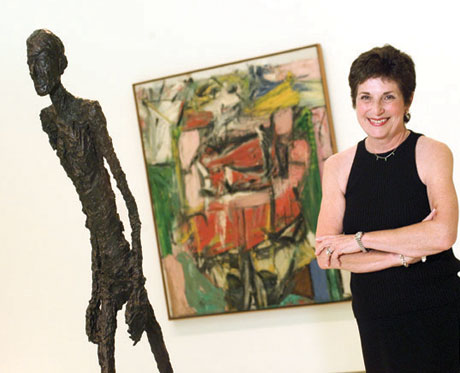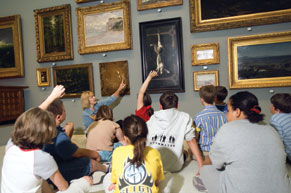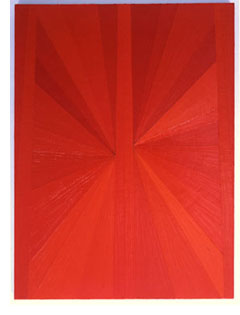Look, Discuss, and Learn:
How Docents Guide Museum Visitors
By Lorrie Flom

Marcia
Rubenstein, chair, Carnegie Museum of Art’s
docent committee, stands in front of two pieces in
the collection that visitors ask about most often:
Willem de Kooning’s Woman VI, and Albert Giacometti’s
Man Walking. Photo: Tom Altany
What makes a trip to Carnegie Museum of Art meaningful
for the thousands of people who visit each year?
Ask any of the docents, and they’ll probably agree
that taking away a greater understanding of even one
work of art makes the experience worthwhile. The docents,
who serve as volunteer guides and educators, receive
extensive training on the works within the Museum of
Art—including temporary exhibitions such
as the Carnegie International.
The docents’ goals, according
to Marilyn Russell, the museum’s curator of education,
are “to
bring greater insight and understanding to the works
of art by generating discussion and by placing the
works in the context of society, world events, and
the individual life of the artist.” Russell explains
that, although the docents are knowledgeable about
the individual works, “they don’t tell
visitors what a painting or sculpture means, but instead
they help the viewers to react to the work of art in
its historical and aesthetic context and from their
personal point of view.”
Many
docents at the Museum of Art say that 20th-century
works tend to
elicit the most questions, as well as
the strongest reactions. Abstract contemporary works
such as Willem de Kooning’s Woman VI and Ryman’s
Issue initially perplex visitors, who often ask such
questions as, “Why is this art?” and “What
is this worth?”, frequently followed by, “I
could do that!” What pleases the docents most
is seeing the pleasure that follows their in-depth
discussion about the work. “De Kooning’s
Woman VI is a favorite of mine to discuss with students,” says
Kathe Patrinos, co-chair of the docent committee. “Students
relate more to the contemporary works. They love
being challenged.”
 Rather than lecturing, the
docents turn to a widely used art education technique
called “visual
thinking strategies” in which the visitors
are asked multiple questions that encourage them
to closely
examine the artwork and draw their own conclusions. “We
then provide tidbits of information that help to
support the viewers’ comments,” says
Patrinos. She notes that the docents especially enjoy
stepping
back while a debate spontaneously occurs within a
tour group. Rather than lecturing, the
docents turn to a widely used art education technique
called “visual
thinking strategies” in which the visitors
are asked multiple questions that encourage them
to closely
examine the artwork and draw their own conclusions. “We
then provide tidbits of information that help to
support the viewers’ comments,” says
Patrinos. She notes that the docents especially enjoy
stepping
back while a debate spontaneously occurs within a
tour group.
The more familiar and beloved works such
as Monet’s
Waterlilies and John Singer Sargeant’s Portrait
of a Boy typically generate positive responses
and a great deal of discussion. Some of the other
contemporary
works that intrigue visitors are the Silver Coat
by Yayoi Kusama with its multiple protrusions and
Alberto
Giacometti’s Man Walking. Docent Emily Stevick
says that hearing a few key facts about Giacometti’s
sculpture “helps visitors identify with the
worn down but firmly fixed figure.”
Marcia
Rubenstein has served as a docent for 20 years
and is the current chair of the committee.
In her
experience, the strength of the museum’s
collection is its variety. “Visitors respond
to a cross-section of works ranging from the very
old, such as the Ancona
Altarpiece from 1472, to the very new, such as
works purchased from the recent Carnegie Internationals,” she
explains. “As docents, we try to reach out
and engage visitors so that they have a pleasurable
experience.
We want them to leave the museum with the desire
to return again.”
Patrinos concurs. “It’s hard to put into
words how wonderful it is to share the excitement of
someone realizing they’ve connected with the
artwork…that in a sense they have taken possession
of the artwork. You can feel the electricity.”
UPDATE:

Artists from Five Continents to Exhibit at 2004 Carnegie
International
 Thirty-eight
artists from around the world have been selected to
exhibit their works at the
2004 Carnegie
International, which opens October 9, 2004, and runs
through March 20, 2005. The exhibition will include
more than 400 works—paintings, sculpture, photography,
works on paper, and film and video—by both
internationally renowned and emerging artists. In
addition, the show
will incorporate small monographic exhibitions of
three important older artists, including new sculpture
and
drawings by American artist Lee Bontecou; a retrospective
of drawings, comic strips, and notebooks by Robert
Crumb, an American-born artist living in France;
and a series of sculptures and artists’ books
by the late Croatian artist, Mangelos (Dimitrije
Basicevic´). Thirty-eight
artists from around the world have been selected to
exhibit their works at the
2004 Carnegie
International, which opens October 9, 2004, and runs
through March 20, 2005. The exhibition will include
more than 400 works—paintings, sculpture, photography,
works on paper, and film and video—by both
internationally renowned and emerging artists. In
addition, the show
will incorporate small monographic exhibitions of
three important older artists, including new sculpture
and
drawings by American artist Lee Bontecou; a retrospective
of drawings, comic strips, and notebooks by Robert
Crumb, an American-born artist living in France;
and a series of sculptures and artists’ books
by the late Croatian artist, Mangelos (Dimitrije
Basicevic´).
Above: R. Crumb, Untitled (Carnegie International poster),
2004,
Courtesy of the artist (© 2004) and Paul
Morris Gallery, New York
Hailing from Asia, Africa, Europe,
North and South America, the artists have been
selected for their
contributions to the world of contemporary art
over the past four
years. Curator Laura Hoptman says that while each
artist offers a distinct view of the world through
his or
her work, “they each consider and use art
as a meaningful vehicle through which to confront
what
philosophers have called ‘the Ultimates’—that
is, the largest, most unanswerable questions ranging
from the nature of life and death, to the existence
of God, to the anatomy of belief.”
 Works
in the 2004 Carnegie International range from
the premier of a large and ambitious video
project
by Istanbul-based video artist Kutlug Ataman
to new paintings by Peter Doig, Neo Rauch, and Julie
Mehretu,
and large-scale color photos by Philip-Lorca
diCorcia.
For artists Tomma Abts, Paul Chan, Jeremy Deller,
Mark Grotjahn, and Eva Rothschild, this exhibition
will
be their debut at an American museum. Works
in the 2004 Carnegie International range from
the premier of a large and ambitious video
project
by Istanbul-based video artist Kutlug Ataman
to new paintings by Peter Doig, Neo Rauch, and Julie
Mehretu,
and large-scale color photos by Philip-Lorca
diCorcia.
For artists Tomma Abts, Paul Chan, Jeremy Deller,
Mark Grotjahn, and Eva Rothschild, this exhibition
will
be their debut at an American museum.
The 2004
Carnegie International marks the 54th installation
since the International was established
in 1896 by
Andrew Carnegie. Today it is North America’s
most renowned exhibition of international contemporary
art. For a complete list of artists participating
in the 2004 International, visit www.cmoa.org/international.
Above: Mark
Grotjahn, Untitled (Orange Butterfly),
2002, oil on linen,
Courtesy of the artist; Blum and Poe, Los Angeles;
and Anton Kern Gallery, New York
____________________________________________________________________

Left,
Emil Nolde, German, 1867-1956, Tänzerinnen
(Dancers), 1917, woodcut on tan, thick, moderately
textured, wove paper, (copperplate engraving),
Milwaukee Art Museum
From the early decades
of a unified Germany to the years of Adolf Hitler’s
rise to power, Expressionism was the dominant avant-garde
art form in Germany. Some of the most dramatic works
from the major German Expressionist artists of this
era are on view in Defiance Despair Desire: German
Expressionist Prints from the Marcia and Granvil
Specks Collection through August 8, 2004. The exhibition,
organized by the Milwaukee Art Museum, features more
than 200 works by 32 artists who collectively changed
the course of Modernism with their radical styles,
techniques, and subjects.
Expand
Your Expressionist Experience—
Attend
an Education Program
The following programs complement Defiance Despair
Desire and are open to the public.
Lunch and Learn:
Defiance Despair Desire: German Expressionist Prints
Thursday, July 15, 10:30 a.m.-2 p.m.
$25 members/$30 non-members
Fee includes lunch in Carnegie Café
Reservations required, 412.622.3288
Participants learn how and why a group of young artists
working in the opening decades of the 20th century
turned to printmaking to express their response to
the radical transformation of life
in Germany.
 Bier Party! Art & Brewing - Bier Party! Art & Brewing -
Two Great
German Traditions
Thursday, July 15, 6-9 p.m.
$25 admission
Reservations required, 412.622.3288
Open galleries and an exhibition party featuring
a sampling of a variety of beers from Pittsburgh’s
Penn Brewery will be part of an entertaining evening
where visitors enjoy two German art forms—printmaking
and great beer. A special tutorial tasting with Penn
Brewery owner, Tom Pastorius, will be available for
members only.
Max Pechstein, German, 1881-1955. Tänzerin
im Spiegel (Dancer in the Mirror),
1923, Milwaukee
Art Museum
Recent Aquisition:
Nakashima Table Added to Decorative Arts Collection

George Nakashima, Japan, 1905-1990, Table, 1958-1959,
walnut Gift of Blanche F. and John T. Galey ©
Peter Haroldt, Photographed in Galacrest, Somerset.
Throughout his career as an architect-turned-woodworker,
Japanese-American George Nakashima (1905-1990) won
numerous international awards for his exceptional
craftsmanship and furniture design. This massive
walnut table, commissioned by Blanche and John Galey
for their house in Somerset, Pa., was delivered in
January 1960, about one year after its commission.
Nakashima wrote to the Galeys, “We were pleased
to have heard that you like your table. It is so
personal that I was a bit concerned as to how you
would react. And so big.” The table was placed
in the home’s main room, where it remained
until 2004, when it was given as a gift to Carnegie
Museum of Art by Mrs. Galey (now Mrs. James Alexander).
“
This is a very important table,” says Curator
of Decorative Arts Sarah Nichols. “It’s
notable for its huge scale, its beautiful figuring
of the wood, and for the natural gnarled effect
of the walnut that Nakashima incorporated into
the work.” According
to Nichols, experts regard this table as one of
the best examples of Nakashima’s furniture.
With works in many of the most important collections
in the world, including the Metropolitan Museum
in New York, the Boston Museum of Fine Arts,
the Victoria
and Albert Museum in London, and the National
Museum of Modern Art in Tokyo, Nakashima remained
humble
about his work and reverent toward nature. This
table was built in his studio in New Hope, Pa.,
where he
worked following his internment during World
War II. Now under the helm of his daughter, Mira,
the
Nakashima Woodworking studio continues to build
commissioned works incorporating the techniques and
philosophy first
set forth by
its founder.
The Nakashima table will be on view
in the Scaife Galleries following the close of
the 2004 Carnegie
International.
Back to Contents |